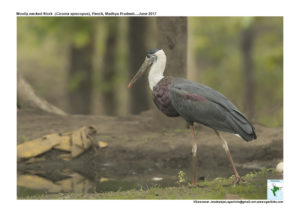Wooly-necked Stork

Woolly-necked Stork Ciconia episcopus
Etymology:
- Ciconia : Latin word for stork
- Episcopus : Latin word for Bishop refers to the black cap, or purple or blue plumage.
Vernacular Names:Hindi: Haji laqlaq, Sans: Shwetakanthmahabak, Pun: Dhing, Ben: Manikjor, Ass: Kanua, Guj: Kali tul, Dholidokdhonk, Mar: Bagula, Kardok, Kandesur, Kowrow, Pandhryamanechakarkocha, Ta: Vannathinaarai, Mal: Karimkokku, Sinh: Padilikokka
Distribution inIndia:Widespread resident, except for North West, Peninsular East and eastern India
Description: Size of 75-92cm. The stork is glistening black overall with a black “skull cap”, a downy white neck which gives it its name. The lower belly and under-tail coverts are white, standing out from the rest of the dark coloured plumage. Feathers on the fore-neck are iridescent with a coppery-purple tinge. These feathers are elongated and can be erected during displays. The tail is deeply forked and is white, usually covered by the black long under tail coverts. It has long red legs and a heavy, blackish bill, though some specimens have largely dark-red bills with only the basal one-third being black. The iris is deep crimson or wine-red. Both sexes are alike. The immature is duller and browner
Habitat: It is found in wetlands such as rivers, lakes, flood plains, marshes, lakes, paddy fields, drying ponds, flooded pastures, waterholes, lagoons, freshwater and peat swamp forest; it prefers waterlogged ground .
Food Habits: It eats fish, frogs, toads, snakes, lizards, large insects, crabs, reptiles, molluscs and marine invertebrate.
Breeding Habits: They breed in July –Sept in South India and Dec-March in North India.Nests are in a tall tree, such as silk cotton often near a village. The nest is a large stick platformwith central depression lined with grass and rubbish. They lay a clutch of 2–4 eggs. The incubation period is 30–31 days and fledging period is 55–65 days